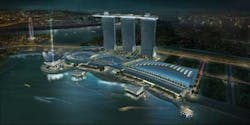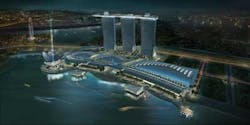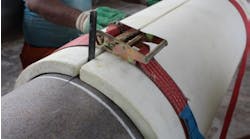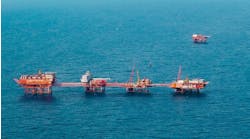The annual Offshore Asia Conference & Exhibition heads to Singapore’s new Marina Bay Sands Resort on March 29-31 expecting to expand on its success in 2010. More than 5,000 attendees from more than 60 countries are expected to hear about new technologies, regional trends and challenges, and to see the latest in offshore equipment and services from more than 100 companies.
The industry advisory board that leads the conference and has set a Plenary Sessions that features David Paganie, conference director and chief editor ofOffshore; Lim Kok Kiang, director of Transport Engineering, Singapore Economic Development Board, welcoming attendees; Jacob Dweck, head of LNG, Sutherland, looking at the impact on global offshore operations of the Macondo disaster in the US Gulf of Mexico; and a regional offshore activity forecast.
The 2011 Offshore Asia Conference and Exhibition will be in Singapore's new Marina Bay Sands Resort complex.
That opening session will be followed by a technical program with two tracks to cover offshore exploration and production technology and applications. Session topics in the first track include well construction and drilling operations, production optimization, risk management, challenges specific to Asia/Pacific upstream oil and gas operations, flowlines and pipelines, and construction and installation.
New this year, the second technical track concentrates on LNG. Topics include commercial and trade issues, supply, markets, analyses, and technology.
Tuesday, March 29, registration is open from 08:30 to 18:00, and the exhibition hall is open from 13:00 to 18:30. From 17:00 to 18:30 there will be an Opening Night Reception on the exhibition floor.
Wednesday, March 30, registration is 08:30-18:00. The Opening Plenary Session runs from 09:00 to 10:00. The exhibition hall opens at 10:00 and the conference sessions at 11:00. Both end at 18:00.
Thursday, March 31, registration is from 08:30 to 16:00; exhibitions are scheduled from 09:00 to 16:00, and conference sessions from 09:30 to 16:00. The awards ceremony and closing remarks are set for 16:00 to 16:15.
On both Wednesday and Thursday there are coffee breaks and delegate lunches scheduled on the exhibit hall floor.
For the most recent registration and schedule information, seehttp://www.offshoreasiaevent.com/index.html. Times and locations are subject to change.
The advisory board to Offshore Asia consists of Julian Callanan, Infield Systems Ltd.; Dr. Gregory Chiu, Asian Institute of Technology; Tony Findlay, Fluor Offshore Solutions; Gary Foulis, Schlumberger (retired); Mads Hjelmeland, Framo Engineering Asia Pacific Sdn Bhd; Barry J. O’Donnell, Pearl Energy; Phil MacLaurin, Premier Oil; David Paganie, PennWell Corp.; Chandru Sirumal Rajwani, Keppel FELS Ltd.; Brian Reeves, Oil & Gas Field Facilities Consultants Ltd.; Joseph H Rousseau, ABS Pacific; Will Rowley, Acteon; John Samson, Aker Solutions; John A. Sheffield, John M Cambpell & Co.; Rodney Silberstein, ARV Offshore Co. Ltd; Ricky Simic, Oil States Industries Inc.; Geoff Stone, Penspen Ltd./Andres Palmer & Associates; Warren True, PennWell Corp.; Dr. Joko Widjaja, Technip Eng. Thailand Ltd.; and Rene Wit, PDO.
Sponsors of the conference and exhibition are ABS; Aker Solutions; Cameron; Oil State Industries; the Gas Association of Singapore; ITF; Singapore Exhibition & Convention Bureau; YourSingapore.com; Offshore magazine; the Oil & Gas Journal; the Oil & Gas Financial Journal; Oil, Gas & Petrochem Equipment; PennEnergy; Energy Asia, LNG OneWorld; Marine, Offshore Shipbuilding, Maps Globe, Offshore Industry, and Orange.
Following are abstracts of some presentations and technologies scheduled for the conference:
Blowout preventer testing—advanced technology development
Engr. Charles Franklin
Innovative Pressure Testing LLC
A step-change in leak detection/pressure testing using a digital solution rather than the traditional circular chart recorder (CCR) is available.
The initial development focused on testing BOP equipment (BOPE) in deepwater. More than 2,000 individual pressure tests were used to validate the Thermally Compensated Leak Detection (TCLD) transform. The transform allows the processing of digital data that shows to be optimum for leak detection.
A small leak may not be identified for up to 20 minutes into the high-pressure test using conventional CCR means. The development provides for enhanced leak detection during the low-pressure test.
In addition, a slow leak is objectively identified in less than two minutes during the high-pressure test, and a test validated in the regulatory agencies minimum holding time requirements. This is an improvement upon the 15 to 60 minutes or more per individual test using a CCR or other methods.
The presentation will showcase the assurance, transparency, accuracy, archiving, and efficiency benefits of the new equipment. TCLD delivers a critical rig path time savings of three to 12 hours, every time the BOP and manifold are tested. With the software, procedures and training, more than a week of time savings per deepwater rig year can be saved. Further leak detection and pressure analysis opportunities for pipelines also will be addressed.
Drillstem testing—operational and safety aspects
Shangkar Venugopal
Halliburton
Well testing costs typically account for approximately one-third of the cost of developing an exploration well. There are many difficulties inherent to these operations. For this reason, it is critical that careful planning be considered as the key step in the development of a testing operation that provides the desired parameters of both the operator and the service company in the safest and most cost-efficient manner.
This presentation provides insight into the techniques and procedures practiced by Petronas in collaboration with a major service company to provide all the operational and safety steps required for a successful drillstem testing (DST) operation. This testing program uses a structured approach that will guide the user through the best practices necessary to effectively plan and implement a DST operation under just about any circumstance.
DST operations must be designed to deal with whatever variables that are defined in the safest, most cost-efficient fashion. The method presented in this paper enables the testing design to address properly the following:
- Design parameters for contingency conditions that are not present normally during equipment operations but could exist in emergency situations
- Problems and solutions associated with perforation, adverse hole conditions, and high-pressure/high-temperature conditions
- Environmental requirements that provide information associated with risk management and legislations.
By following the documented processes disclosed in this paper, testing operations can be developed to avoid catastrophic events that could occur in the safest and most cost efficient manner.
Anchoring Malaysia’s first deepwater FPSO
Dr. Samy Alhayari
SBM Offshore
The 10 suction piles for Murphy Oil’s first deepwater FPSO,Kikeh, have been installed successfully in more than of 1,300 m (4,265 ft) in about five days using SBM/Solstad Normand Installer.
SBM’s new “GAP: Gravity Actuated Pipe” was used for the first time to transfer the fluid from the spar to the FPSOMDFT (Malaysia Deep Floating Terminal), a joint venture of SBM Offshore and Malaysian MISC. Peak production is about 120,000 b/d of oil.
The challengingKikeh seabed conditions – with the presence of a telecom cable in the middle of one mooring bundle, excessive seabed slopes, and other complicated geology – have forced both parties to find a cost-effective and appropriate anchoring solution of the FPSO. The FPSO mooring was originally designed with three-by-three legs but one of the bundles has to be increased to four legs instead of three to avoid the telecom cable by shorting the anchoring radius and increasing the chain size for that bundle. The FPSO is anchored to the seabed using 10 suction piles.
The constructive cooperation between Murphy Oil and MDFT during the site surveys allowed adjustments to the anchoring radius and anchor points to a less risky area during the execution of the geophysical survey and prior to carry out the seabed testing and sampling boreholes.
The FPSO is hooked-up to her ten legs and GAP connected between the spar and the FPSO. Subsea risers are being secured to the FPSO turret prior to start production.
This is the first application of the suction pile technology offshore Malaysia. The coordination among SBM Offshore’s various departments during the design, fabrication, and installation key to this success.
Real-time condition monitoring of subsea pipelines
Jon Machin
Schlumberger
Ensuring the structural integrity of subsea pipelines is a concern for many operators in the Asia/Pacific region. This presentation describes several ways in which real-time monitoring technology is emerging as an increasingly significant component of a solution to this problem. New fiber-optic sensors are described. These sensors can obtain both discrete and distributed information regarding key structural integrity properties of the pipeline in addition to operating conditions such as pressure and temperature. Advances in installation methods and procedures means that these sensors can be deployed cost-effectively in new field applicatons as well as retro-fiitted to existing facilities. Case studies illustrating a number of applications are described.
Case studies on subsea production optimization
Ian Donald
Cameron MARS Production Systems
The presentation shows the benefits of wellhead-based subsea processing. It describes in detail how the standardized wellhead interface MARS (Multiple Application Re-injection System) has been deployed successfully on numerous subsea production optimization projects.
In addition to discussing subsea multiphase pumping and metering applications, the presentation focuses on the recent successful deepwater well stimulation on Chevron Lobito Tomboco project in deepwater Angola. This project was completed in December 2009. The presentation will show how application of emerging technologies allows operators to maximize recovery using low-risk, low-cost tooling.
Fluid intervention no longer requires full vertical well access for wireline or coiled tubing services. Chemicals now can be pumped into the well (or pipelines) in a controlled, safe manner without MODU facilities. There are a number of fluid intervention applications. They are used to protect the well against scale and hydrates; or to pump kill weight brine for well control; or to clean the lower completion or stimulating the reservoir to then tackle formation/production issues that evolve throughout the life of the well.
The presentation also shows how to verify the principles of the unitized processing and the potential applicability to typical assets and provides additional technical information by updating actual projects, confirming the business case advantages of using this standardized interface, detailing how the technology can strategically to “future proof” assets , and presenting the HSE advantages of standardized tooling and procedures
Lastly, the presentation provides details of current projects and system adoption by multiple vendors, suppliers, and operators to further standardize interfaces.
Offshore Articles Archives
View Oil and Gas Articles on PennEnergy.com




